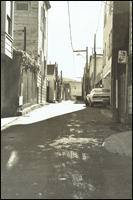By Paisley Trent
El Tecolote
Branching off 24th Street in the Mission are alleyways filled with colorful murals and engaging graffiti tags. Balmy Alley and Clarion Alley rotate the work of artists depicting local and international issues. The sides of buildings are covered in these depictions of culture, identity, current events, neighborhood and city history and solidarity.
Among these murals are strong visuals of children fighting with soldiers, walls being destroyed and commentary on struggles related to the U.S.-Mexico border.
Mission artist Lucía Ippolito conveys a more global perspective of the border crisis, showing solidarity with international struggles in her 2015 colored pencil work, “Borders.” Ippolito says the work is intended to connect Palestine, Mexico and Syria, as each community deals with different refugee and migrant crisis.
The colors in the piece pull from the flags of Mexico, Syria and Palestine. Depictions of Mexican culture and the U.S.-Mexico border are the immediate background, behind a Palestinian woman in chains. The people portrayed are pushed forward by the changing wall that winds through the piece and turns from barbed wire with a security camera to the tall concrete of Israel’s separation wall and lastly into a wooden fence that continues into the ocean, where a raft of Syrian refugees approach.

“I was trying to connect these topics,” Ippolito said. “As human beings, I feel we are going to look back on history and look how we treated the most vulnerable amongst us.”
Ippolito’s piece was recently included in “LA FRONTERA: Artists respond to the U.S.-Mexico Border,” an exhibition at the Jewish Community Center (JCC) that focuses on themes of global turmoil, migration and border issues. The exhibit, which opened April 25, runs until September 2019.
However, shortly after the show’s opening, Ippolito’s work was removed without notice and she only learned of the censorship after her work was taken down. She decided to withdraw entirely from the show, feeling since her piece was removed, the goal of the exhibit to generate dialogue was sidestepped.
David Green, JCC’s Chief Program Officer for Roots & Culture, wrote in a statement and apology that Ippolito’s work, and an additional work by artist Christo Oropeza, were removed after complaints that the works depicted violence toward children. Though the Katz Synder gallery holds regular shows, it isn’t a dedicated gallery space, having work hang next to classrooms and in the walls across from an outdoor playground.
After discussions, Ippolito said she was eventually asked by the curator of the exhibit, David de la Torre, for a replacement piece, specifically about the U.S.-Mexico border. This request confirmed Ippolito’s belief that her work was censored due to its portrayal of Palestine, in addition to concerns showing a dead child.
In lieu of a request for a replacement work, Ippolito offered to have her public statement about the censorship of her work displayed, though due to a delayed response from Green she has not provided it as of yet.
Several artists, who are part of the show, have written an open letter condemning the removal of the works and have respectfully withdrawn their works in solidarity with Ippolito and Oropeza.

Vandalism and Zionism
The inclusion of the works by Ippolito and Oropeza in the art show and the reasons for its removal have become a flashpoint in the rising tensions surrounding artwork featuring Palestinian activists, symbols of Palestinian liberation, solidarity with Palestine and differing definitions of Zionism.
Recent vandalism of murals, weekly protests in front of a new business and more recent art highlighting Palestinian resistance and culture are indicative of national issues that have stirred tensions visibly present in the Mission District.
In Clarion Alley, anonymous vandals have repeatedly defaced five murals depicting solidarity with Palestine. Since September, the murals have been vandalized 15 times after continuous repairs—the most recent occurring in the first week of June, soon after repairs were made to a damaged mural on June 3.
While works may be regularly tagged and occasionally painted over by different artists without permission, the recurring vandalism on the same murals is unprecedented for Clarion Alley, says Christopher Statton, co-director of the Clarion Alley Mural Project (CAMP).
Clarion Alley, which connects Valencia and Mission streets, was founded by CAMP as a place for social justice, activism and community mural art. Over a hundred thousand tourists and local residents walk through annually since 1992.
“Clarion Alley represents so many cultures and languages,” said CAMP Co-Director Megan Wilson. “Some works are personal to people that live in the Mission, but also there’s universal stories that have international reach.”
Chris Gazaleh, a Palestinian-American artist, activist and educator from the Bay Area, has long painted murals in Clarion Alley and the Mission that center around Palestine, Arab culture and solidarity movements between communities.









